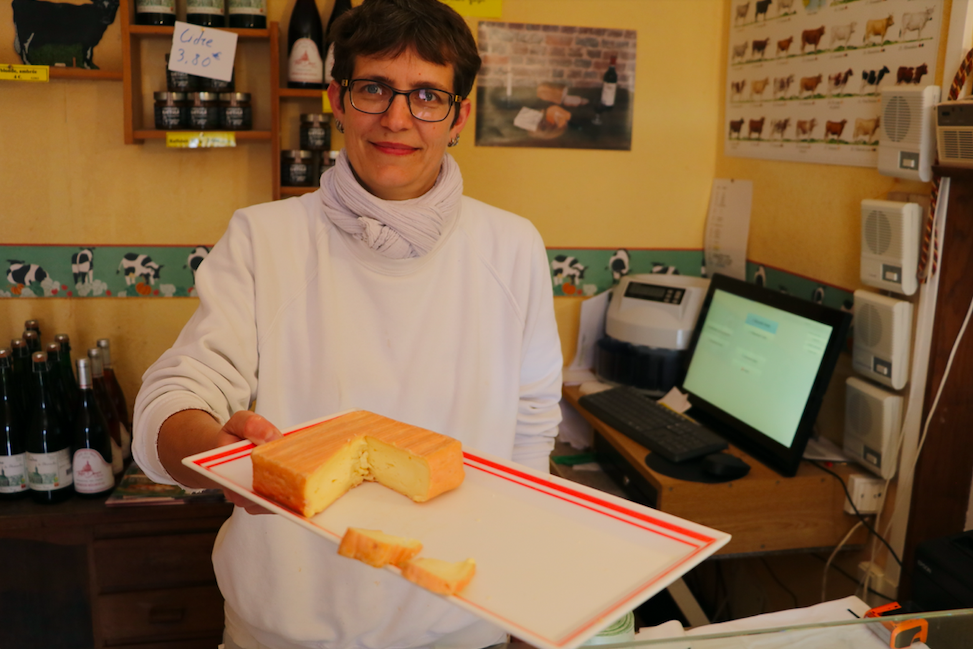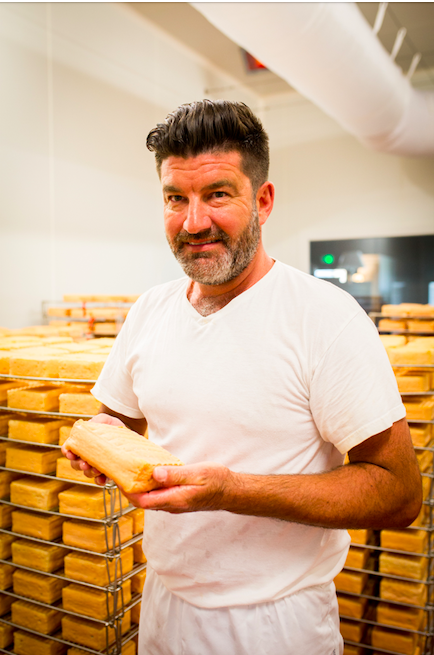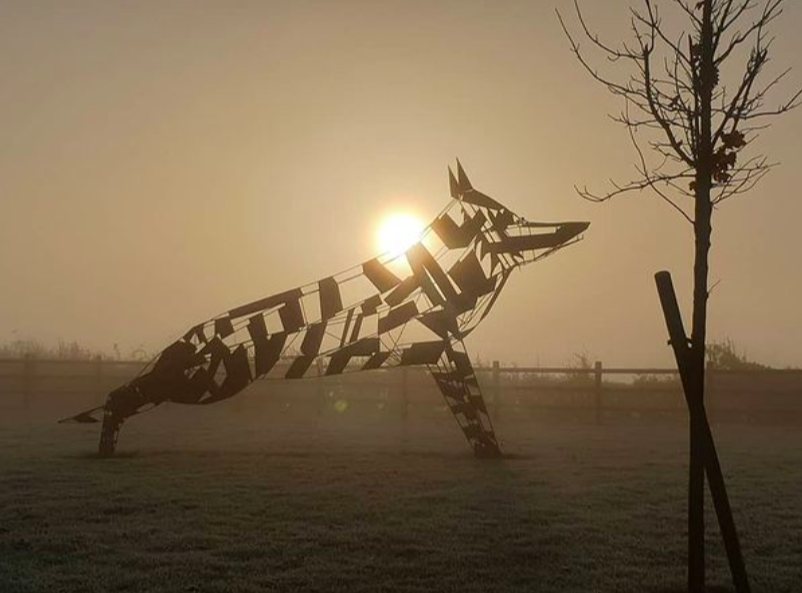Maroilles: The wonder of Fromage – unveiling one French cheese at a time
Maroilles is far from the most well-known of cheeses, though fans of French comedies may remember it earning a cameo in Bienvenue Chez les Ch’tis, the 2008 film from Dany Boon.
The film tells the story of a southern French postal worker banished to the cold and dreary North after pretending to be disabled. (Yikes.)
Upon his arrival on the border between France and Belgium, which he considers a no-mans-land, poor Philippe is horrified to find that, in stark contrast to the sweeter breakfasts known throughout the rest of France, his colleagues in the North are partial to a savory morning meal that sees the washed rind cheese dipped into their morning coffee, ostensibly to reduce its holy stink.

But really… who eats stinky Maroilles for breakfast?
When I ask her about the tradition, cheesemaker Aurélie Halleux-Labroche, who makes the cheese alongside her husband in the historic region of Thiérache can’t help but laugh.
“People think that’s a cliché, but it’s not!” she says. “I know older people who do it still.”
While she concedes that these days, most young locals are far more likely to enjoy a tartine, croissant, or yogurt in the morning, she notes that “when you’ve got cows, you’ve got to milk them.” If breakfast comes after three hours of work, even at 9 am, Maroilles could be a welcome treat.
“It’s not really morning anymore!”
But a breakfast sure to put hair on your chest is not the only memorable trait of this delightful Northern treat.

Maroilles is a member of the category of washed-rind cheeses, home, too, to Burgundian Epoisses, Italian Taleggio, and German Limburger. Known perhaps above all for their odor, these cheeses are made, as the name of their category suggests, by washing the rind regularly, either in brine or, in the case of Epoisses or Welsh Golden Cenarth, for instance, in alcohol (Marc de Bourgogne and cider, respectively).
But Maroilles stands out from the other members of the category for a few reasons.
First off, Maroilles is one of the oldest of its kind, invented in the 10th century by an abbot at the Abbey of Maroilles. It also boasts a fairly unique shape – that of a square – thanks to the hardwood of the North, which is more difficult to bend into a ring than the softer woods of other regions. And unlike Epoisses, Maroilles doesn’t run away from you once you slice into it; instead, it boasts a hefty chew that is almost meaty in texture.
Protected by AOC since 1955 (and AOP since 1996), Maroilles is sometimes dubbed “the finest of the strong cheeses” – le plus fin des fromages forts. And while according to second-generation Maroilles producer Alexandre Gravez of the Ferme du Pont aux Loups, “all Maroilles is good,” both experts contend that there are a few elements that can push the cheese from merely bon to extraordinaire.

While the AOP allows for Maroilles to be made with raw, pasteurized, or thermalized milk, in the opinion of Halleux-Labroche, a great Maroilles must, “first and foremost,” be made with the former. She and her husband produce their raw milk on-site, grazing their cows as much as possible in order to create a product even more rooted in the local terroir.
It’s never the same milk… you’re working with something that’s alive, so that’s very interesting.”
Aurélie Halleux-Labroche
Maroilles texture – what’s to know
She also contends that beneath a Maroilles’ sticky orange rind, the cheese should have a distinct double texture: a creamy layer surrounding a chalky center. While the AOP dictates that a Maroilles must be cellar-aged for at least 35 days, her goal is to craft cheeses that only get better with time.
Consumed around 60 or 65 days, they boast even more body, flavor, and aroma.
Gravez agrees, noting that after 70 days in the cellar, with twice-weekly washing in brine, a Maroilles becomes “much creamier.”
“The chalky heart at the center will begin to disappear,” he says, “and you’ll get a cheese that’s really quite unctuous, a bit more flavor-forward, but without being aggressive.”
The crust, too, will change, he says; the reddish-orange a Maroilles is usually known for will have “died” and faded to a browner color.
“It will have a nice character to it,” he says, noting that while many fear that older necessarily means stronger, this isn’t necessarily the case.
“On the contrary,” he says, “some of its aromas will be more present, but it will also be a lot creamier.”
Like Halleux-Labroche, Gravez still makes Maroilles according to ancestral methods. His farm is 50 years old, and he and his family have been producing Maroilles here for 30 of them.
“Since I was very small, we’ve been working on the farm,” he says of the family operation he now shares with his siblings. “It’s part of our DNA.”
Gravez driven by passion
And while he never felt pushed by his parents to join the family business, for him, “it’s really a passion.”
“At any rate, to make cheese, to be a farmer, you need to be passionate.”
Gravez’s enthusiasm for his trade has notably led him to diversify his offerings. In addition to AOP Maroilles and Vieux Lille – a cheese made with a Maroilles base treated with even more salt, a holdover from preservation methods predating refrigerated trucks – Gravez also makes the ancestral Dauphin, so named for the crown prince and future king Louis XV, who apparently took a liking to the product made from young Maroilles rubbed in tarragon.
And he has even invented a few creations of his own, like the creamy and assertive T’Chiot Biloute, named for a term of endearment in the local patois. Gravez uses the milk from his own cows to make his AOP Maroilles and Vieux Lille, and he buys the milk for his newer specialties from his uncle, who farms just next door, keeping everything in the family.
Both experts concede that while they love Maroilles, with its assertive aroma and bite, it can be a tough one to wrap your head around, at first.




You often get the image of Maroilles as… I mean, it is a strong-smelling cheese. That’s a reality.
concedes Alexandre Gravez
But, he notes, in spite of its powerful aroma, “it’s not a cheese that has a strong flavor or is aggressive.” Indeed, behind that pungent nose is something creamy, lactic, and almost buttery.
“People stop because of the smell,” says Halleux-Labroche. “But on the palate, it’s very mild; it’s a subtle cheese.”
How does Gravez eat his Maroilles?
Gravez likes to eat his Maroilles “right off the knife,” enjoying it with red wine, sweet white wine, or even with liquor.
“I wouldn’t say it’s sweet,” he says, “but it can soften the power of the alcohol slightly.” Halleux-Labroche, meanwhile, is a big fan of pairing the cheese with another local specialty: beer. Indeed, as compared to the rest of France, the North is one of the biggest beer consumers, due in part to its proximity with Belgium, and a rich, flavorful beer is a welcome match for any washed-rind cheese.
“A Chimay Bleue with Maroilles is so good,” says Halleux-Labroche. “There’s nothing better.”
Maroilles is also an excellent cheese to cook with, according to both farmers, who cite local recipes like tarte au Maroilles, cheese-spiked cream sauces, or baked endives topped with the cheese and baked until burnished and bubbly. Halleux-Labroche even likes using Maroilles in place of Reblochon to render a typical Savoyard specialty, tartiflette, a little more Northern.
“It gives off all of its aromas and flavors when cooked,” she says.
Or why not try it as les anciens do and dip it in your morning coffee?
Have you tried Maroilles? Would you dunk it in your coffee for breakfast? Share your thoughts in the comments section below.
Image credits
1. copyright Aurélie Halleux-Labroche
2. copyright Alexandre Gravez
3. copyright Ferme du Pont aux Loups
4-7. Copyright Emily Monaco
Here you can read all articles in this column:
‘The wonder of Fromage – unveiling one French cheese at a time’ by Emily Monaco







I so loved this piece on Maroilles!!! I hail from the suburbs of Lille, so Maroilles was close to always present on the cheese tray at dinner parties that I would attend. I feel so-so about this very pungent cheese, though – it is tough for me to get beyond its smell. But I d eat it sometimes.
An anecdote: When I was a teenager, my family drove to Avesne, town of origin of another cheese that is somewhat related to Maroilles, if only for its extremely stinky quality. Of course, we bought some, and had to drive home with the car windows down!!!